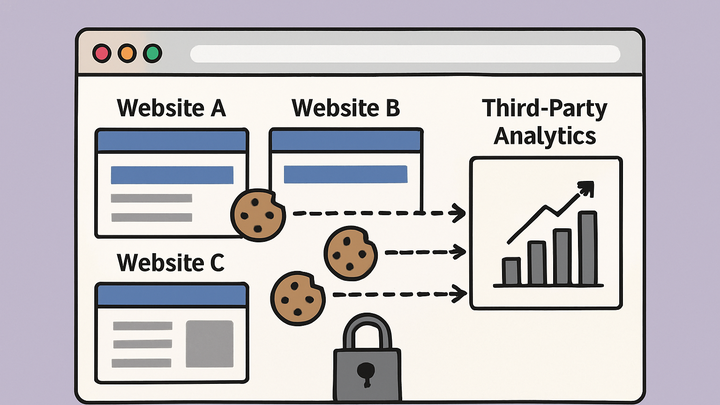Published on 2025-06-26T04:46:20Z
What is a Third-Party Cookie? Examples in Analytics
Third-party cookies are browser cookies set by domains other than the website a user is visiting. They enable cross-site tracking for analytics, advertising, and personalization by storing identifiers that can be read across multiple domains. While useful for building user profiles and attributing ad conversions, they have become controversial due to privacy concerns and potential misuse. Leading browsers and regulations are phasing out or restricting third-party cookies in response to user demand for greater privacy. Analytics platforms are adapting by shifting to first-party cookies, server-side tracking, and cookie-free approaches like PlainSignal’s lightweight script and GA4’s event-based model.
Third-party cookie
Browser cookies set by external domains for cross-site tracking, used in analytics and advertising but raising privacy concerns.
Understanding Third-Party Cookies
Third-party cookies are created when a webpage loads resources (like scripts or images) from a domain
different than the one in the address bar. The external domain sends a Set-Cookie header, and
the browser stores that cookie. On subsequent visits to any site requesting resources from the same
third-party domain, the browser includes the stored cookie in requests, enabling the domain to recognize the
user across multiple websites.
-
Definition
A third-party cookie is a cookie created by a domain other than the one the user is currently visiting, commonly used for cross-site tracking and personalization.
-
How they work
When a page embeds content from an external domain—such as ads, pixels, or analytics scripts—that domain can issue and read cookies even though it does not appear in the address bar.
-
Http set-cookie header
The third-party server instructs the browser to store a cookie via the
Set-Cookieresponse header when its resource is loaded. -
Cross-site context
Each time the browser requests resources from that third-party domain on any site, it sends the stored cookie, enabling cross-site user recognition.
-
Impact on Analytics and Privacy
Historically, third-party cookies powered sophisticated behavioral analytics and precise ad attribution by following users across the web. However, they also exposed detailed browsing profiles to advertisers and raised significant privacy concerns. As a result, major browsers and regulations are limiting or blocking third-party cookies, forcing analytics teams to seek new approaches.
-
Analytics use cases
Marketers and analysts rely on third-party cookies to stitch together user journeys across multiple domains and measure campaign performance.
-
User behavior profiling
Compiles actions from different sites to build comprehensive interest and demographic profiles.
-
Ad attribution
Links ad impressions on various publisher sites to conversions by tracking the same identifier across domains.
-
-
Privacy concerns and regulations
Growing user demand for privacy and legal frameworks have driven restrictions on third-party tracking.
-
Browser restrictions
Safari (ITP), Firefox (ETP), and Chrome’s Privacy Sandbox plan to block or limit third-party cookies by default.
-
Regulatory compliance
GDPR and CCPA require explicit user consent for cross-site tracking and impose strict data handling requirements.
-
Modern Alternatives and Implementation
With third-party cookies on the decline, analytics teams are moving to first-party cookies, server-side approaches, and fully cookie-free solutions such as PlainSignal and Google Analytics 4 (GA4).
-
PlainSignal cookie-free analytics
PlainSignal delivers privacy-first analytics without relying on any browser cookies, using device fingerprinting and server-side logging.
-
How it works
By hashing key request headers and logging events server-side, PlainSignal tracks pageviews and custom events anonymously.
-
Integration example
Add the PlainSignal snippet to your site:
<link rel="preconnect" href="//eu.plainsignal.com/" crossorigin /> <script defer data-do="yourwebsitedomain.com" data-id="0GQV1xmtzQQ" data-api="//eu.plainsignal.com" src="//cdn.plainsignal.com/plainsignal-min.js"></script>
-
-
Google analytics 4 (GA4)
GA4 prioritizes first-party cookies and leverages event-based data models with machine learning to fill gaps when cookies are blocked or deleted.
-
First-party cookie model
Cookies are stored under your website’s own domain, reducing cross-site tracking and improving control over data.
-
Machine-learning modeling
GA4 uses statistical modeling to infer missing user interactions when cookies are unavailable or blocked.
-
